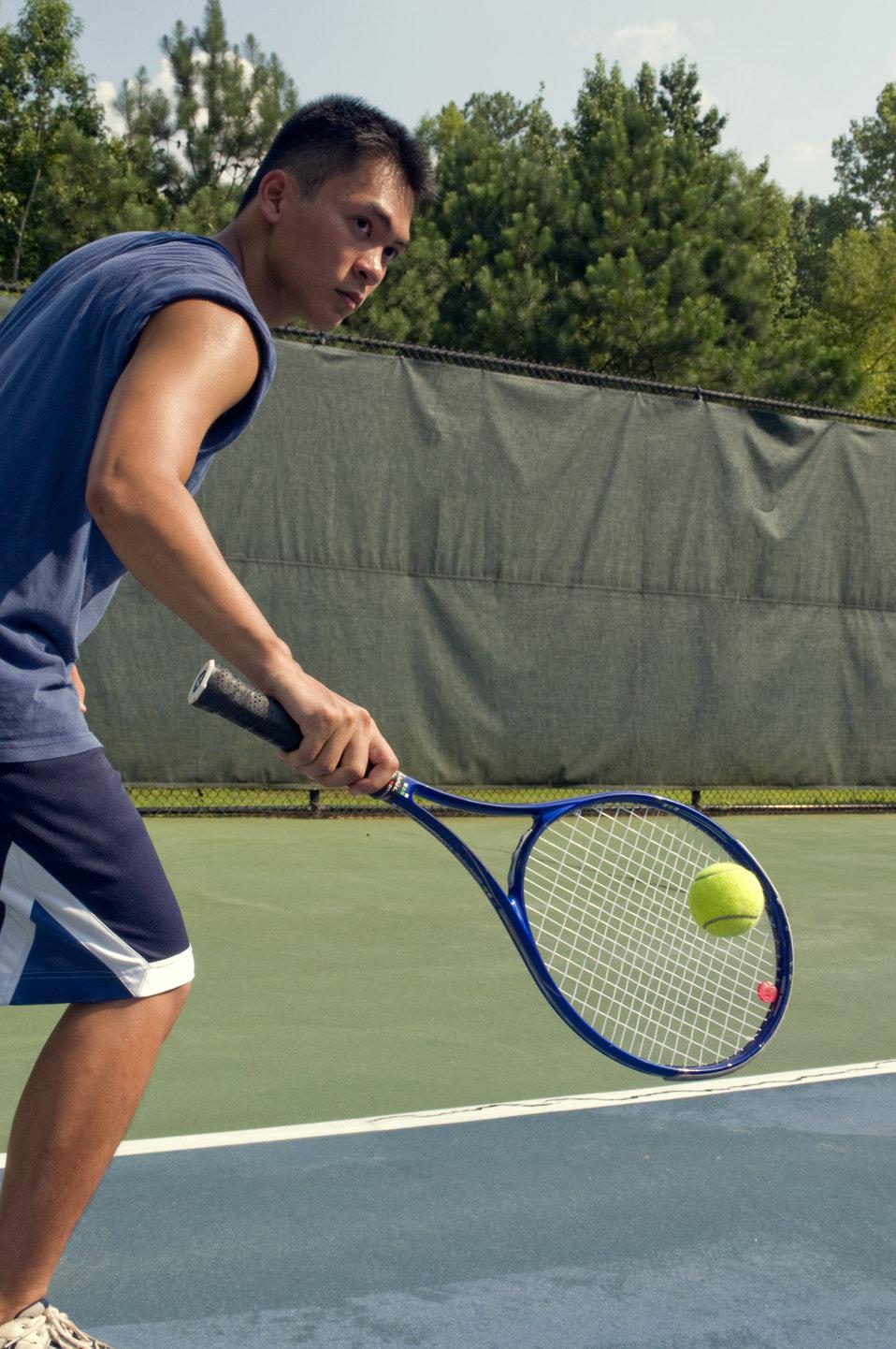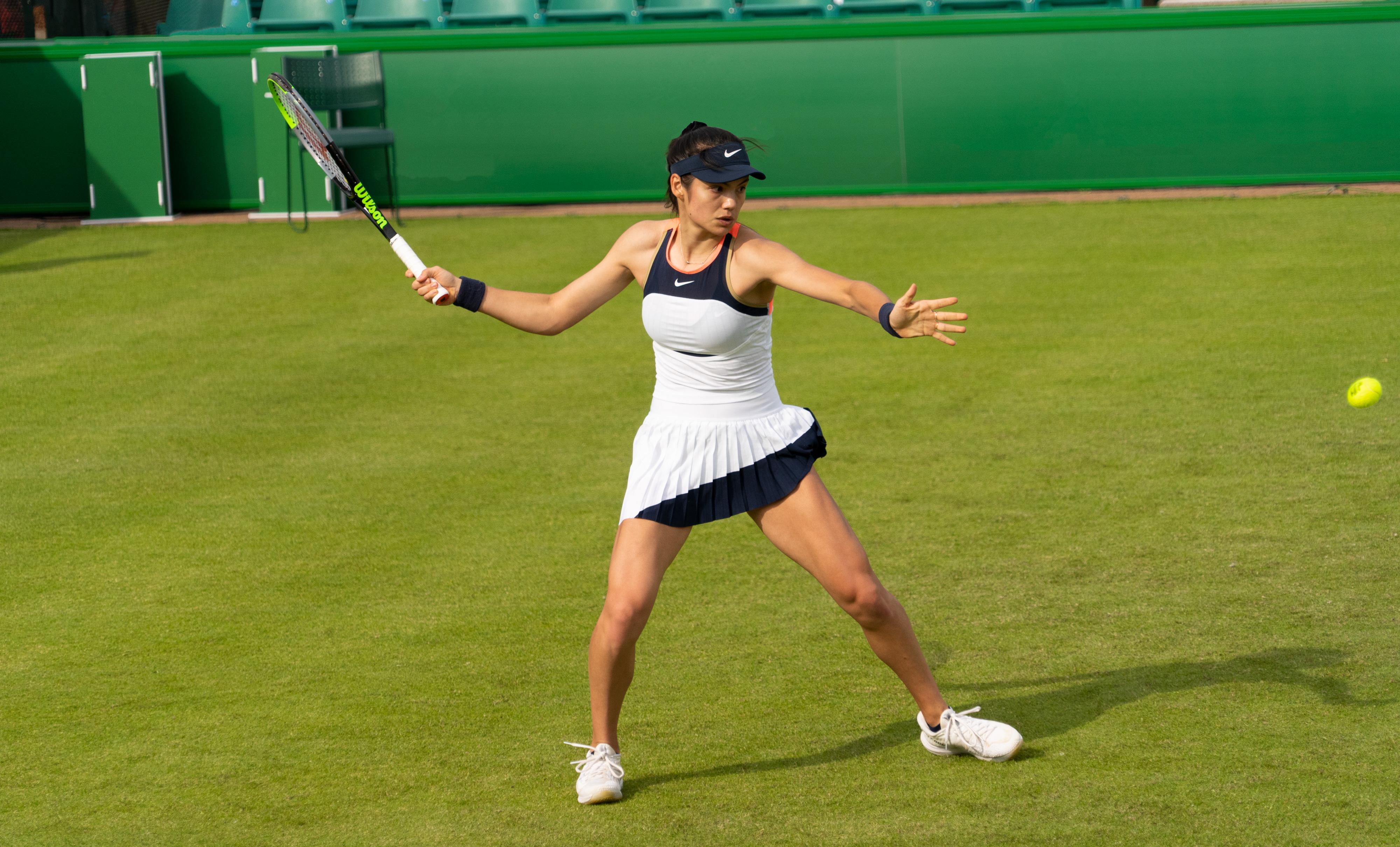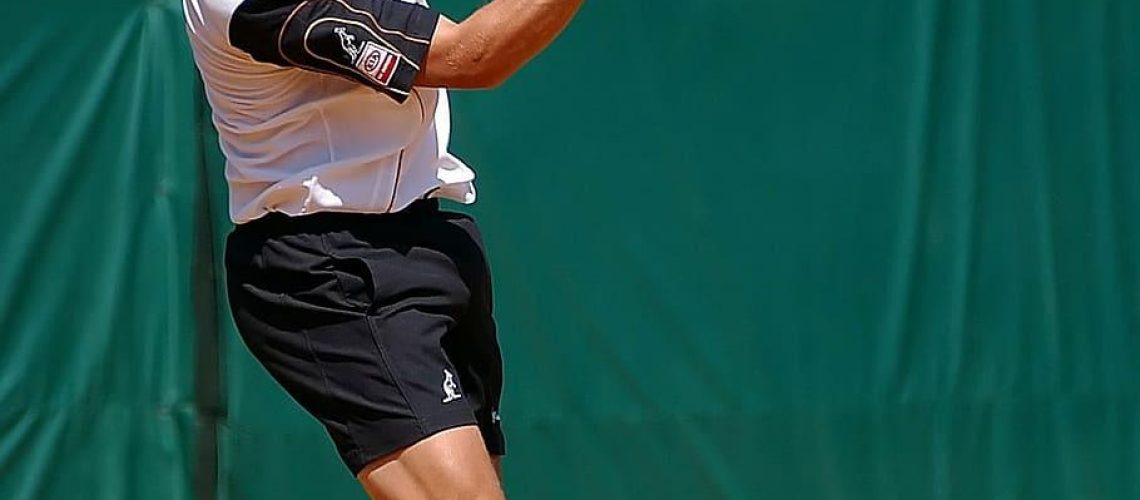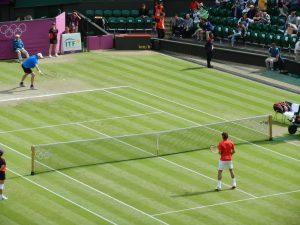We may earn money or products from the companies mentioned in this post.
The Importance of a Proper Tennis Swing

When it comes to playing tennis, a proper swing is crucial for both enhancing performance and reducing the risk of injury A well-executed swing can make all the difference in your game, allowing you to hit powerful shots with precision and control
Enhancing Performance
A proper tennis swing is essential for maximizing your performance on the court It allows you to generate more power and accuracy in your shots, giving you an edge over your opponents With a solid technique, you’ll be able to hit the ball with more force and placement, making it harder for your opponent to return
Furthermore, a correct tennis swing ensures that you can maintain consistency in your shots By executing the same motion repeatedly, you develop muscle memory which leads to greater accuracy and control This consistency will enable you to execute different types of shots effectively, such as baseline strokes or net approaches
Reducing Injury Risk
In addition to improving performance, a proper tennis swing also helps reduce the risk of injury Tennis involves repetitive motions that can put strain on various parts of the body, particularly the shoulders and wrists
By using correct technique and body mechanics during your swing, you can minimize stress on these vulnerable areas This reduces the likelihood of developing overuse injuries like tennis elbow or shoulder impingement syndrome Additionally, a balanced swing allows for better weight transfer throughout the body, reducing strain on specific joints or muscles
Overview of Four Main Types of Tennis Swings

Forehand
The forehand is one of the most fundamental strokes in tennis and is used when hitting balls on your dominant side (for right-handed players, this would be their right side). It involves swinging across the body in a diagonal motion, generating power from the rotation of the hips and shoulders Mastering the forehand allows you to hit powerful shots with topspin or flat trajectory
Backhand
The backhand stroke is executed on your non-dominant side (for right-handed players, this would be their left side). It can be performed using either a one-handed or two-handed grip The one-handed backhand requires more strength and coordination, while the two-handed backhand provides more stability and control Developing a solid backhand technique is crucial for a well-rounded game
Serve
The serve is arguably the most important shot in tennis, as it initiates each point It involves hitting the ball over the net into your opponent’s service box A powerful serve can put pressure on your opponent and give you an advantage in the point Proper technique is essential for generating speed and accuracy, utilizing leg drive and shoulder rotation
Volley
The volley is a shot that is played before the ball bounces on your side of the court It requires quick reflexes and good hand-eye coordination The key to an effective volley is using a compact swing with precise racket positioning to redirect the ball with control and precision
Mastering the Forehand Swing

The forehand swing is a fundamental skill in tennis that can make or break your game To truly master this technique, it’s important to understand the proper grip for a forehand swing There are three common grips to consider: the Eastern grip, Semi-western grip, and Western grip Each grip has its own advantages and disadvantages, so finding the one that suits your playing style and comfort level is key
1 Eastern Grip
The Eastern grip is often recommended for beginners as it provides a solid foundation for learning the basics of the forehand swing With this grip, you position your hand on the racket handle so that the base knuckle of your index finger rests on bevel two This grip offers good control and stability but may limit your ability to generate topspin
2 Semi-western Grip
The Semi-western grip is a popular choice among intermediate players due to its versatility In this grip, your hand will be slightly rotated towards bevel three, allowing you to generate more topspin while still maintaining control over your shots It offers a balance between power and spin, making it suitable for players who want to add more aggression to their game
3 Western Grip
The Western grip is known for its extreme topspin potential and is commonly used by advanced players seeking maximum spin on their shots With this grip, your hand will be positioned further towards bevel four or even five, resulting in a more closed racket face during contact with the ball While it allows for exceptional spin generation, it can also decrease control and power
Footwork and Body Positioning

Perfecting your footwork and body positioning is crucial for executing a powerful forehand swing As you approach the ball, remember to pivot on your back foot and step into the shot with your front foot This movement helps generate power and allows for better weight transfer Additionally, aligning yourself properly with the incoming ball is essential for optimal timing and accuracy
1 Pivot and Step into the Shot
To effectively transfer energy into your shot, initiate the forward swing by pivoting on your back foot while simultaneously stepping forward with your front foot This coordinated movement allows you to generate power from the ground up, resulting in a more explosive forehand swing
2 Alignment with the Incoming Ball
Positioning yourself correctly in relation to the ball’s trajectory is vital for a successful forehand swing By anticipating where the ball will land, you can adjust your body positioning accordingly Aligning yourself parallel to the net and ensuring that your non-dominant shoulder points towards the incoming ball will optimize your hitting zone and increase consistency
Stages of the Forehand Swing

The forehand swing consists of two primary stages: preparation phase and contact phase Understanding these stages will help you execute a well-rounded stroke with proper technique and form
1 Preparation Phase: Racket Take Back and Shoulder Turn
In the preparation phase, focus on taking your racket back early to create ample time for proper shot execution Simultaneously, initiate a shoulder turn by rotating your upper body away from the net as you prepare to make contact with the ball This phase sets up an efficient transfer of energy during the contact phase
2 Contact Phase: Contact Point, Hitting Zone, and Follow-Through
The contact phase is where the magic happens Aim to make contact with the ball in front of your body, slightly in front of your leading foot This enables you to generate power and control while also facilitating topspin Your hitting zone should be at waist level or slightly higher, ensuring a clean strike and consistent shot placement Lastly, follow through with your swing, extending your arm forward and across your body for added power and control
Common Mistakes to Avoid in Your Forehand Swing

As with any skill, there are common mistakes that players often make when attempting a forehand swing By being aware of these errors, you can avoid them and improve the effectiveness of your shots
Mastering the Backhand Swing

The backhand swing is an essential skill for any tennis player looking to improve their game It requires a combination of technique, footwork, and body positioning to execute it effectively In this article, we will explore the different types of backhand swings, choosing the right grip for your preferred style, footwork and body positioning tips, the stages of the backhand swing, and common mistakes to avoid So let’s dive in!
Two types of backhand swings
When it comes to backhand swings in tennis, there are two main types: the one-handed backhand and the two-handed backhand
-
One-handed backhand:
The one-handed backhand is a classic technique where you use only one hand on the racket This type of swing offers greater reach and versatility but requires more wrist strength and control -
Two-handed backhand:
The two-handed backhand is a popular choice among players as it provides added stability and power due to the use of both hands on the racket It can be easier to learn for beginners but may limit reach compared to the one-handed technique
Choosing the right grip for your preferred backhand style
Selecting the appropriate grip is crucial for executing an effective backhand swing For a one-handed backhand, using an Eastern or Semi-Western grip allows better control and topspin generation On the other hand, a two-handed grip typically involves using an Eastern or Continental grip with your dominant hand and a Continental or Eastern forehand grip with your non-dominant hand
Footwork and body positioning
To perform a successful backhand swing, you need to focus on your footwork and body positioning
-
Pivot and step into the shot:
Start by pivoting on your back foot as you transfer your weight onto your front foot Take a small step forward with your lead foot as you initiate the swing, allowing for a smooth weight transfer -
Alignment with the incoming ball:
Position yourself in line with the incoming ball to ensure proper timing and contact Keep your body balanced and square to the net, allowing for better control and accuracy in your shots
Stages of the backhand swing
The backhand swing can be broken down into two main stages: the preparation phase and the contact phase
-
Preparation phase:
During this stage, focus on taking your racket back while simultaneously turning your shoulders This helps generate power and sets up the correct hitting position for an effective shot -
Contact phase:
The contact point is crucial for a successful backhand swing Aim to make contact slightly in front of your body, keeping a firm wrist and extending through the ball Follow through with a smooth motion that allows for maximum power and control
Common mistakes to avoid in your backhand swing
In mastering the backhand swing, it’s important to be aware of common mistakes that can hinder your progress
-
Gripping too tightly:
Avoid gripping the racket too tightly as it restricts wrist movement and hampers fluidity in your swing -
Lack of shoulder turn:
Failing to properly rotate your shoulders during the preparation phase can result in a weak and ineffective shot -
Incorrect footwork:
Improper footwork can lead to poor timing and positioning, impacting the power and accuracy of your backhand swing Practice proper pivot and step techniques to avoid this issue
By understanding and implementing these techniques, you’ll be on your way to mastering the backhand swing Remember to practice regularly, seek guidance from a coach if needed, and stay focused on improving your skills Happy swinging!
Mastering the Serve

When it comes to serving in tennis, having the proper grip is essential The Continental grip is widely regarded as the most effective grip for serving With this grip, you hold the racket as if you are shaking hands with it This allows for a greater range of motion and flexibility, enabling you to generate more power and control in your serve
The stages of a successful serve

Ball toss
The first stage of a successful serve begins with the ball toss It’s important to have a consistent and controlled toss that goes slightly ahead and above your hitting shoulder This will ensure that you can make solid contact with the ball at the optimal height
Trophy position
After the ball toss, you should strive to reach what is known as the trophy position In this position, your non-dominant hand should be pointing towards the sky while your dominant hand holds the racket behind your head This position helps create a coil-like energy that can be unleashed into your serve
Racket drop
The next stage is the racket drop As you begin to bring down your racket from the trophy position, focus on using a relaxed wrist and forearm movement This will allow for better timing and coordination when making contact with the ball
Contact point
The contact point is where all your preparation comes together Aim to make contact with the ball slightly in front of your body and at an optimal height – typically around waist level or slightly higher Making clean contact at this point will result in a powerful and well-placed serve
Follow-through and landing
Once you’ve made contact with the ball, follow through with your swing by extending your arm fully and finishing with a smooth motion As you complete your follow-through, make sure to land on the front foot for better balance and stability
Types of serves

Flat serve
The flat serve is known for its speed and power It is hit with a fast swing and minimal spin, making it difficult for opponents to return This serve is particularly effective when aiming for the corners of the service box
Slice serve
The slice serve involves adding sidespin to the ball, causing it to curve away from your opponent This can be a useful weapon to catch your opponent off guard or force them into an uncomfortable position on the court
Kick serve
The kick serve utilizes topspin to make the ball bounce higher and kick off the court This can be an effective strategy against opponents who struggle with high-bouncing balls or have difficulty returning serves that are directed towards their backhand side
Common mistakes to avoid in your serve

-
Gripping too tightly:
Holding onto the racket too tightly can restrict your wrist movement and reduce power in your serve -
Inconsistent ball toss:
A poor ball toss can lead to timing issues and result in mis-hits or double faults -
Lack of body rotation:
Neglecting proper body rotation can limit power generation in your serve and put unnecessary strain on your arm -
Poor balance:
Failing to maintain good balance throughout your serving motion can affect accuracy and control
To truly master the art of serving in tennis, it’s important to focus on these key elements and continuously practice to refine your technique With dedication and perseverance, you can develop a serve that is both powerful and consistent
Mastering the Volley

The volley is a crucial technique in tennis that requires skillful execution to control the ball and dictate play To become proficient in this aspect of the game, it is essential to understand the proper grip, footwork, body positioning, and techniques involved In this article, we will delve into these key elements and discuss common mistakes to avoid when volleying
Proper grip for volleying
One fundamental aspect of mastering the volley is adopting the correct grip The most commonly used grip for volleys is known as the continental grip This grip involves placing your hand on the racket handle with your index knuckle resting on the third bevel (V-shape) of the handle The continental grip allows for versatility in executing both forehand and backhand volleys effectively
Footwork and body positioning
Maintaining proper footwork and body positioning is vital when approaching a volley A key element in setting yourself up for success is performing a split step just before your opponent’s shot reaches you This quick hop enables you to react swiftly and adjust your position accordingly
a Forehand volley split step:
For a forehand volley, perform a split step by jumping off both feet simultaneously while keeping them shoulder-width apart This helps you stay balanced and ready to move in any direction
b Backhand volley split step:
When preparing for a backhand volley, execute a split step with one foot slightly forward compared to the other, depending on your dominant hand’s side (left or right). This position facilitates an efficient transfer of weight during your stroke
Techniques for executing effective volleys
-
Shortening the backswing:
To maintain control and quick reactions, it is crucial to keep your backswing compact when volleying Minimizing the backswing allows for better racket head control and enhances your ability to redirect the ball with precision -
Angle of the racket face at contact:
Another critical aspect of executing effective volleys is ensuring a proper angle of the racket face at contact For forehand volleys, aim to have a slightly open racket face to generate topspin and help keep the ball in play Conversely, for backhand volleys, a slightly closed racket face helps maintain control and accuracy -
Punching through the ball with a compact follow-through:
When making contact with the ball, focus on punching through it rather than decelerating This technique ensures that you transfer power into your shot while maintaining control Additionally, finishing with a compact follow-through allows for quicker recovery and readiness for subsequent shots
Common mistakes to avoid in your volley
-
Inadequate footwork:
Neglecting proper footwork can lead to being off-balance or unable to reach certain shots effectively Practice split steps and positioning drills regularly to enhance your footwork skills -
Poor timing:
Timing is crucial in volleying as mistimed shots result in errors or weak returns Focus on anticipating your opponent’s shot by studying their body language and racquet preparation -
Inconsistent grip pressure:
Maintaining consistent grip pressure throughout your volley stroke is essential for stability and control Avoid gripping too tightly or too loosely; find a balance that allows you to maneuver the racket effortlessly
To become proficient in volleying, it requires consistent practice and attention to the key elements discussed By mastering the proper grip, footwork, body positioning, and executing effective techniques, you can elevate your volley game to new heights
Conclusion

Practice makes perfect: importance of repetition
As the saying goes, practice makes perfect This age-old adage holds true when it comes to mastering any skill or technique The more you repeat a task or practice a specific technique, the better you become at it Repetition allows your brain to form strong neural connections, reinforcing the pathways that lead to mastery
When it comes to writing techniques and frameworks, repetition is key By consistently practicing different writing styles and approaches, you can refine your craft and strengthen your skills Whether it’s brainstorming ideas, outlining your content, or fine-tuning your sentence structure, repetition will help you improve and become a more proficient writer
Adapting techniques based on personal style and strengths
While learning from established frameworks and techniques is valuable, it’s important to adapt them according to your personal style and strengths as a writer Each individual has their unique voice and perspective that sets them apart from others
Experiment with different writing techniques and find what works best for you Some writers may excel at storytelling while others shine in persuasive arguments or informative pieces Understanding your strengths will enable you to leverage them in your writing style, making your content more engaging and authentic
Seek instruction from experienced coaches
No matter how skilled we are as writers, there is always room for growth and improvement Seeking guidance from experienced coaches or mentors can provide valuable insights into refining our writing abilities
An experienced coach can offer constructive feedback, help identify areas of improvement specific to our writing style, and provide guidance on honing our skills further They bring expertise gained through years of practice themselves, offering invaluable advice that can propel us towards becoming better writers
In conclusion, mastering the art of writing requires consistent practice, adapting techniques to suit your personal style and strengths, and seeking guidance from experienced coaches By incorporating these elements into your writing journey, you can continuously improve your skills and create engaging and impactful content
Useful Links

Swing A Tennis Racket Like A Weight Instead Using It …
How to Hit a Forehand | Tennis Forehand | Tennis Swing
Tennis Technique: Swing Path and Spin from Racquet Tip
Podcast #161: How Hard Should You Swing? –
Out, Up, and Through
HOW TO SWING A TENNIS RACKET
Coach-approved Tips To Improve Your Tennis Forehand
Forehand grip and swing for beginner players
Tennis Forehand Technique & Drills [Slow Motion Video!]
Tennis Racquet and Swing Speed Contributions To Shot …
Reminders to Self
How to Choose a Tennis Racket
YJSD Power Resistance Tennis Racket, Professional …
5 Tips to Improve Your Forehand
What Are The Techniques To Swing A Tennis Racket?
Swingweight –
How to pick the correct Tennis racket? A comprehensive …






